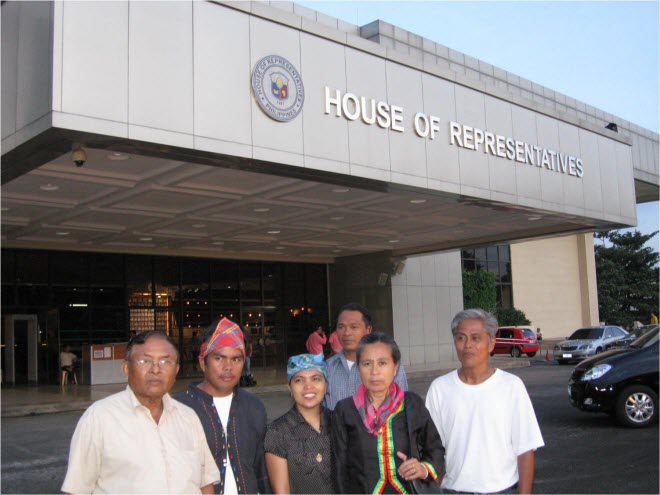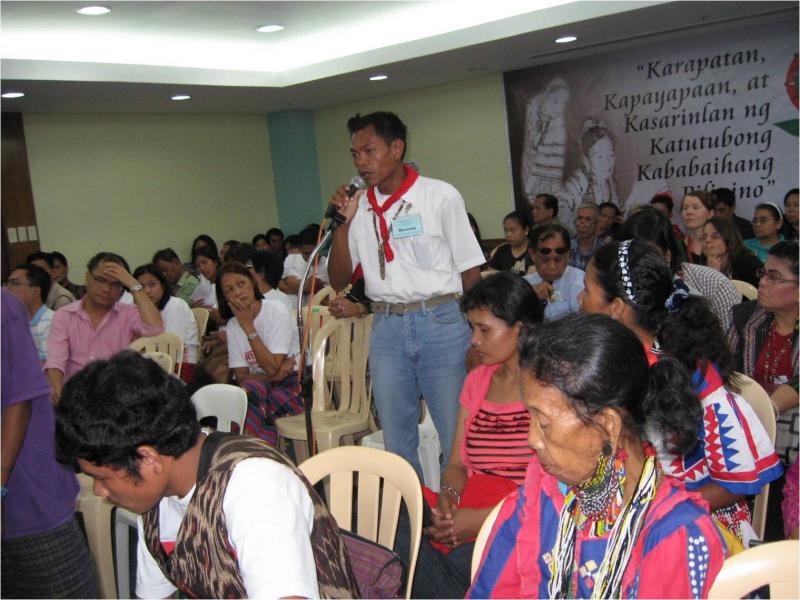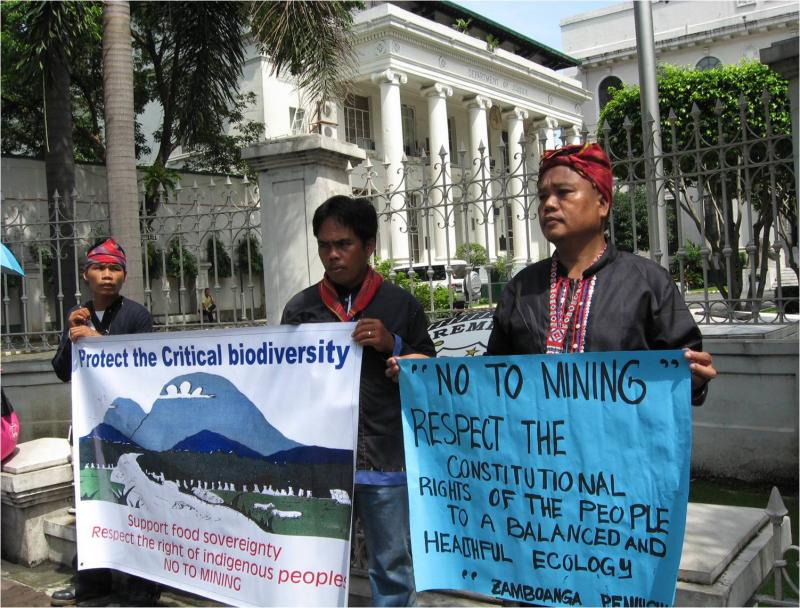Hope For Midsalip
By Mary Joy Rile
There can be no peace without equitable development; and there can be no development without sustainable management of the environment in a democratic and peaceful space. This shift is an idea whose time has come. ~ Wangari Maathai ~
Mindanao, Ang Yutang Gisaad, ‘The Land of Promise’ to its people. The many stories I grew up with – of the diverse natural beauty, the multi-cultural nature, the many stories of struggles, frustrations, hopes and successes – in that part of the country fed my curious mind and a longtime dream of landing on Mindanao soil. That dream was granted when Anne Gubuan, our assistant editor, and I reached Ozamiz City on 24 June, our first stop. We were to visit different areas where Columbans are present. And on 27 June I went to Midsalip, Zamboanga del Sur.

The claim for ancestral domain is the longtime plight of the Lumads. Many parts of Mindanao are being used up by outsiders and foreigners leaving the Lumads landless or running after the land which was supposed to be theirs. Midsalip in particular is just one part of the ‘promised land.’
I remember the article The Heart that Pumps Water which we featured in Misyon in May-June 2010 with Pat McCarthy writing about the Mt Pinukis ranges, through which I first learned the reality in Midsalip. Going there, I was hopeful to see improvements after a year. But to my surprise, what I discovered was truly heartbreaking.
Reaching Balay Bityalan Nu Ngak Subanen, the apostolic center of the Columban Sisters, I and my companion Virgie Oral were taken by motorcycle to the mining picket area. I met only a few people as we had to rush back after only ten minutes because of rain. The three of us got really wet. Imagine the difficulty of riding a motorcycle, of which I am not fond, holding an umbrella at one hand and keeping balance as we rode through the rain down the bumpy road, though I must admit that I somehow enjoyed that extraordinary moment, considering the rain a blessing from the heavens. Our consolation was that what we were experiencing was nothing compared to the many struggles of the Subanens.
Balay Bityalan Nu Ngak Subanen
Back to the center, we were humbled by the presence of the Subanens and some of the accused Fr Sean Martin wrote about in When It Rains It Pours! A criminal case was filed in the Regional Trial Court of Aurora against nine people including himself and Peruvian Columban Sister Patty Adonaire in October 2010, on the grounds of obstruction of the operation of drilling machine for mining. A civil case was also filed against them in December 2010. A temporary restraining order (TRO) was then released by the judge in favor of the mining companies simply on the basis of the accrued rental charges of the drilling machine. The picketers trying to protect their land were harassed but witnesses denied this. The witnesses, from among the Subanens, were bribed in favor of the mining companies. Subanens, the inhabitants of Midsalip are restrained from walking on their land. ‘The people who are taking care of the land, for irrigation and for food, have now become land criminals,’ uttered Columban Sr Kathleen Melia in disappointment.
Midsalip picket area
The defendants expressed their frustration at the judge’s decisions. When they filed a motion for lack of evidence, there was no action since June. Now, a full injunction is filed against them which could lead to imprisonment.
I asked the defendants how they deal with the case knowing that they have families and other concerns. They expressed that thinking of the situation is causing them confusion and is really depressing. People are worried about their case. But they don’t tell their families everything about the real situation as they don’t want them to worry much.
At that time of my visit, they had already attended 13 hearings in Aurora, usually scheduled at 2:00 PM. Every trip cost them around P3,000.00. Their resources and energy were exhausted.
They believe that what the companies are doing is a clear violation of RA 8371, the Indigenous People’s Rights Act. The Subanens have the right to hold their land and their consent is needed for any activity in it. The certificate for exploration that the mining companies are holding was signed by bribed individuals, not by the real tribal leaders. No consensus was sought. It seemed to be manipulated.
Sr Kathleen shared her views of the situation: ‘If a Subanen cuts down one tree, he is charged for breaking the law. But what about the loggers who move freely? The Subanens have been oppressed in their own land. When mining is permitted, the companies will claim the land, the water, the trees and the rest. There is no justice here in Midsalip.’ Mining is not in the culture of the Subanens but the local government is pro-mining. The exploration began during the previous administration.
The Philippines tends to pattern mining activity on that of other countries in the name of economic development. The big difference is that in other countries it does not pose a high risk to the environment and the people unlike here in the Philippines where we have active volcanoes and geological faults. Mt Pinukis of Midsalip, for example, is the main source for the water system of the three provinces of the Zamboanga peninsula and is a reforested area.
Pagmina o Kasiguroan sa Pagkaon ug Kaugmaon
Message from the Subanens
When I asked some Subanens what message they would like to convey to the public this is what they had to say.
- Let us help in protecting the mountains because this is for the good of everyone.
- The country has a big budget for reforestation but it’s useless since the lands are set aside for mining.
- People should unite to preserve Mother Earth. Man shall perish but Mother Earth will remain.
- The National Commission for Indigenous Peoples (NCIP) tends to view things from a business perspective. They are pro-development when they should be pro-IP.
- Mining is pro-aggression. We call for the government to weigh mining and income.
- The land should be protected and cared for because life lies in it. No mining favors ancestral domains.
- The present administration has not yet issued a ban on mining. It only refers to Republic Act 7942. The court sees the destruction but no executive order or law to stop mining, so it continues. Not just a moratorium on logging but on mining is needed before great destruction happens.
- Culturally speaking, Subanens are into farming and hunting, not into mining. Foreigners introduced mining through some Timu-ay, chieftains or tribal leaders, in the past. According to Subanen belief, if the land is destroyed, a big disaster will soon follow.
- Everything is connected. What happens to one part creates a domino effect. If the Mt Pinukis range is destroyed, it will affect the sacred mountain, Syaman, the water system of the Zamboanga peninsula, the fisher folks, and will affect the rest of creation.
- If mining will continue, we will no longer have materials for our rituals. Mt Pinukis is where we meditate, pray, and is the source of our medicines.
- According to the letter from Mines and Geosciences Bureau (MGB), Mt Sugarloaf and Mt Pinukis should be protected areas.
- Midsalip has two inactive volcanoes, Mt Mediau and Mt Pinukis. But once disturbed, these mountains will most likely become active. It is also affected by frequent earthquakes. The western Mindanao fault line passes by Midsalip.
- We hope that the media will do more to support the anti-mining campaign.
A Light of Consolation
On 22 August, I called up Nitz Clamonte of the Columban Justice, Peace and Integrity of Creation (JPIC) office in Mindanao and learned that good news was on its way.
It is a consolation to finally find support for the case of the Subanens. Different sectors gathered together and planned for the next move.

at the Batasan Pambansa
While the hearing in Mindanao continued, fifteen of the concerned were persuaded by their lawyer to go to Manila to file for a Writ of Kalikasan in the Supreme Court on 9 August seeking the cessation of mining operations in the Zamboanga Peninsula. The petitioners included a Muslim, a bishop, a lay person, local officials, Subanens and representative of different organizations: the Alliance to Save the Integrity of Nature (ASIN), DIOPIM – Dipolog, Ipil, Ozamiz, Pagadian, Iligan, Marawi – Committee on Mining Issue (DCMI), the KesalubuukanTupusumi Organization of Subanen People and Philippine Earth Justice Center Inc.

Participating World Indigenous Peoples Day Celebration
9 August is International Day of the World's Indigenous People. This year’s celebration is of great relevance to Philippine history. Representatives of Indigenous Peoples were invited to the Batasan Pambansa and granted, before the official proceedings, an hour and a half to be listened to. Six of the representatives from different parts of the country spoke and presented their concerns. It was noted that it was the first time in history of the Philippines that representatives of Indigenous Peoples were accommodated and entertained by Congress.

Filing petition for writ of kalikasan at the Supreme Court
And on 16 August, the Supreme Court partially granted the petition. It issued a writ of kalikasan directing the Department of Environment and Natural Resources (DENR) and the Mines and Geosciences Bureau (MGB) to stop issuing mining permits.
Sense of Hope
With the little resources that they have, the Subanens are able to survive with the help of the Columbans, the bishops, the Sisters, some lawyers, representatives in the house of Congress, and other support groups working for the cause of the Indigenous Peoples in our country. They would like to express their gratitude for the support given to them. Truly it is an avenue for many to convene and work for justice. The case continues, but this time the accused individuals are facing it with a sense of hope and gratitude.

Surely the works of the Columbans as missionaries here in the Philippines is very challenging. Jesus spent time with the sick, the poor and the oppressed. Father Sean Martin, Sister Patty Adonaire and other Columbans chose to reach out to the Subanens in the same way, whatever it takes in the name of Mission. This is the way they found when they sought to follow Christ.
Yes, when it rains it pours, but with the peeping of the rainbow, a brighter day is sure to come. I am hoping for a peaceful Philippines. Having gone to Midsalip and seeing things for myself, I have this sense of hope that things will end in a fruitful and peaceful settlement.
= = = = = = = = = =
RELATED LINKS
- Pagmina o Kasiguroan sa Pagkaon ug Kaugmaon, a video on the struggles of the Subanen people against mining
- Mt. Pinukis an arena of debate on mining
- The Heart That Pumps Water
- Philippines: Mining or Food?
- RA 8371: Indigenous Peoples Rights Act
- RA 7942: Philippine Mining Act of 1995